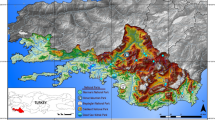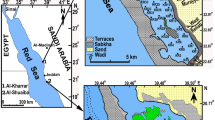Abstract
The study of the diatom ecological preferences was conducted from January 2002 to June 2003 in Canal de Mira, Ria de Aveiro, Western Portugal. Three sampling stations along a salinity gradient were sampled monthly, in new moon, at high and low tide. Salinity, temperature, pH, dissolved oxygen and nutrient contents were measured for each sampling station; chlorophyll a and diatom diversity and abundance were also evaluated. Canonical correspondence analysis was used to identify the environmental variables governing the composition and structure of diatom assemblage. The variation in the species data among the different reaches was strongly determined by the salinity spatial gradient and by the temperature temporal gradient. The lower reaches were dominated by marine species (e.g. Auliscus sculptus, Chaetoceros densus, Fallacia forcipata,Licmophora flabellata, L. grandis, Surirella comis), while in the most upstream station typical freshwater species dominated (e.g. Caloneis permagna, Cymatopleura solea, Cymbella tumida, Gomphonema longiceps, Pinnularia stommatophora, Stauroneis smithii). Weighted averaging was used to estimate optima and tolerances of some diatom taxa for the most influential variables. It was possible to establish groups oftaxa with defined and distinctive salinity and temperature preferences.
Similar content being viewed by others
References
A. Almeida A. Cunha F. Alcântara (2002) ArticleTitleSeasonal change in the proportion of bacterial and phytoplankton production along a salinity gradient in a shallow estuary Hydrobiologia 475/476 251–262
S. F. P. Almeida C. Gil (2001) ArticleTitleEcology of freshwater diatoms from the central region of Portugal Cryptogamie, Algologie 22 109–126
InstitutionalAuthorNameAPHA (1992) Standard Methods for the Examination of Water and Wastewater EditionNumber18 American Public Health Association Washington, DC 991
H. J. B. Birks J. M. Line S. Juggins A. C. Stevenson J. F. ter Braak (1990) ArticleTitleDiatoms and pH reconstruction Philosophical Transaction, Royal Society of London, Series B 327 263–278
S. R. Cooper (1999) Estuarine paleoenvironmental reconstructions using diatoms E. F. Stoermer J. P. Smol (Eds) The Diatoms: Applications for the Environmental and Earth Sciences Cambridge University Press Cambridge 352–373
A. Cunha A. Almeida J. Dias J. Lopes F. Alcântara (2003) ArticleTitleFluxes of bacterioplankton between a tidal estuary and sea: returning to the “Outwelling Hypothesis” Aquatic Ecology 37 45–54
J. M. Dias J. F. Lopes I. Dekeyser (2000) ArticleTitleTidal propagation in the Aveiro lagoon, Portugal Physics and Chemistry of the Earth 25 369–374
H. Germain (1981) Flore des diatomées. Diatomophycées eaux douces et saumâtres du Massif Armoricain et dês contrées voisines d’Europe Occidentale Société Nouvelle dês Éditions Boubée Paris 444
A. Hall M. Lucas (1981) ArticleTitleAnalysis of ammonia in brackish waters by the indophenol’s blue technique: comparison of two alternative methods Revista Portuguesa de Química 23 205–211 Occurrence Handle1:CAS:528:DyaL3sXkslKmtrY%3D
F. Hustedt (1985) The Pennate Diatoms, a translation of Husted’s “Die Kieselalgen, 2. Teil.” With supplement by Norman G. Jensen Koeltz Scientific Books Koenigstein 918
K. Krammer H. Lange-Bertalot (1986) Bacillariophyceae, 1. Teil: Naviculaceae H. Ettl J. Gerloff H. Heying D. Mollenhauer (Eds) Süβwasserflora von Mitteleuropa, 2/1 Gustav Fischer Verlag Stuttgart 876
K. Krammer H. Lange-Bertalot (1988) Bacillariophyceae, 2. Teil: Bacillareaceae, Epithemiaceae, Surirellaceae H. Ettl J. Gerloff H. Heying D. Mollenhauer (Eds) Süβwasserflora von Mitteleuropa, 2/2. Gustav Fischer Verlag Stuttgart 596
K. Krammer H. Lange-Bertalot (1991a) Bacillariophyceae, 3. Teil: Centrales, Fragilariaceae, Eunotiaceae H. Ettl J. Gerloff H. Heying D. Mollenhauer (Eds) Süβwasserflora von Mitteleuropa, 2/3 Gustav Fischer Verlag Stuttgart 577
K. Krammer H. Lange-Bertalot (1991b) Bacillariophyceae, 4. Teil: Achnanthaceae H. Ettl G. Gärtner J. Gerloff H. Heying D. Mollenhauer (Eds) Süβwasserflora von Mitteleuropa, 2/4 Gustav Fischer Verlag Stuttgart 437
D. Lim M. Douglas J. Smol (2001) ArticleTitleDiatoms and their relationship to environmental variables from lakes and ponds on Bathurst Island, Nunavut, Canadian High Arctic Hydrobiologia 450 215–230
C. J. Lorenzen (1967) ArticleTitleDetermination of chlorophyll and phaeo-pigments: spectrophotometric equations Limnology and Oceanography 12 343–346 Occurrence Handle1:CAS:528:DyaF1cXovFOqsQ%3D%3D
K. Muylaert K. Sabbe W. Vyverman (2000) ArticleTitleSpatial and temporal dynamics of phytoplankton communities in a freshwater tidal estuary (Schelde, Belgium) Estuarine, Coastal and Shelf Science 50 673–687
G. Nygaard (1996) ArticleTitleTemporal and spatial development of individual species of plankton algae from European lakes Hydrobiologia 332 71–91
Peragallo, H., & Peragallo M., 1897–1908. Diatomées Marines de France et des Districts maritimes voisins. Koeltz Scientific Books, Koenigstein, 509 pp., pl. I-CXXXVII.
D. W. Pritchard (1989) Estuarine classification – a help on a hindrance B. J. Neilson A. Kuo J. Brubaker (Eds) Estuarine Circulation Human Press Clifton 1–38
M. Revilla A. Ansotegui A. Iriarte I. Madariaga E. Orive A. Sarobe J. Trigueros (2002) ArticleTitleMicroplankton metabolism along a trophic gradient ina shallow-temperate estuary Estuaries 25 6–18
J. Rodier (1984) L’analyse de l’eau, eaux naturelles, eaux résiduaires, eau de mer (chimie, physico-chimie, bactériologie, biologie) EditionNumber7 Dunoud Bordas Paris 1365
F. Round R. Crawford D. Mann (1990) The Diatoms. Biology & Morphology of the genera Cambridge University Press Cambridge 747
P. Sims (Eds) (1996) An Atlas of British Diatoms Biopress Limited Bristol 601
P. Snoeijs (1999) Diatoms and environmental change in brackish waters E. F. Stoermer J. P. Smol (Eds) The Diatoms: Applications for the Environmental and Earth Sciences Cambridge University Press Cambridge 298–333
J. Strickland T. Parsons (1972) A Practical Handbook of Seawater Analysis EditionNumber2 Fisheries Research Board of Canada Ottawa,. Canada 310
M. J. Sullivan (1999) Applied diatom studies in estuaries and shallow coastal environments E. F. Stoermer J. P. Smol (Eds) The Diatoms: Applications for the Environmental and Earth Sciences Cambridge University Press Cambridge 334–351
C. ter Braak P. Verdonschot (1995) ArticleTitleCanonical correspondence analysis and related multivariate methods in aquatic ecology Aquatic Sciences 57 255–289
C. ter Braak P. Smilauer (1998) CANOCO Reference Manual and User’s Guide to Canoco for Windows – Software for Canonical Community Ordination (version 4) Microcomputer Power Ithaca, NY
C. Tomas (1996) Identifying Marine Diatoms and Dinoflagellates Academic Press Inc. San Diego 598
J. Trigueros E. Orive (2001) ArticleTitleSeasonal variation of diatoms and dinoflagellates in a shallow, temperate estuary, with emphasis on neritic assemblages Hydrobiologia 444 119–133
I. Urrutxurtu E. Orive A. Sota (2003) ArticleTitleSeasonal dynamics of ciliated protozoa and their potential food in an eutrophic estuary (Bay of Byscay) Estuarine, Coastal and Shelf Science 57 1169–1182
H. Dam Particlevan A. Mertens J. Sinkeldam (1994) ArticleTitleA coded checklist and ecological indicator values of freshwater diatoms from the Netherlands Netherlands Journal of Aquatic Ecology 28 117–133
J. Weckström A. Korhola T. Blom (1997) ArticleTitleDiatoms as quantitative indicators of pH and water temperature in subarctic Fennoscandian lakes Hydrobiologia 347 171–184
A. Witkowski H. Lange-Bertalot D. Metzeltin (2000) Diatom flora of marine coasts I H. LangeBertalot (Eds) Iconographia Diatomologica A.R.G. Gantner Verlag K.G. Ruggell 925
J. Zar (1996) Biostatistical Analysis Prentice-Hall International Inc. London 662
Author information
Authors and Affiliations
Corresponding author
Rights and permissions
About this article
Cite this article
Resende, P., Azeiteiro, U. & Pereira, M.J. Diatom ecological preferences in a shallow temperate estuary (Ria de Aveiro, Western Portugal). Hydrobiologia 544, 77–88 (2005). https://doi.org/10.1007/s10750-004-8335-9
Issue Date:
DOI: https://doi.org/10.1007/s10750-004-8335-9




